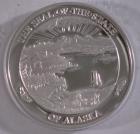1997 Alaska Medallion - The Musk Ox


Current List Price $250.00
Like some of the other back issue Alaska medallions, the 1997 Musk Ox has become difficult to find.
Total one ounce proof mintage: 6,800.
Please CONTACT US for availability information.
Gary Kuchinka of Eagle River, Alaska designed the 1997 Official state Medallion. Its issue price was $29.95.
The group defense formation adopted by muskoxen in response to predators is well known. When danger approaches, muskoxen run together. Every animal tries to face the source of the threat. If only one predator is nearby, the defense formation takes the form of a line. If several predators, such as a wolf pack surround the group, the formation becomes a compact circle with all muskoxen facing outward.
The name musk ox is misleading because the animals have no musky odor. As a species, musk ox have changed little since the ice age and are perfectly adapted to living in arctic climates. The musk ox is a stocky long haired animal with a slight shoulder hump and a very short tail. Both sexes have horns, but the horns of bulls are larger and heavier than those of cows. Mature bulls are about 5 ft. high at the shoulder and weigh 600 to 800 pounds. Cows are smaller averaging approx. 4 ft. in height and weighing 400 to 500 pounds.
The soft brownish wool-like under hair or qiviut has been called the rarest fiber in the world. There is domestic muskoxen herd at Palmer, Alaska where they are exclusively raised of their qiviut. Eskimos on Nunivak Island collect the naturally shed wool of the wild muskoxen which is found clinging to bushes and tundra plants. Once collected, the quviut is spun by hand and made into beautiful scarves, hats, and gloves.
Muskoxen eat a wide variety of plants, including grasses, sedges, forbs, and woody plants. Muskoxen are poorly adapted for digging through heavy snow for food, so winter habitat is generally restricted to areas with shallow snow accumulations or areas blown free of snow.
Silver Trivia
The area of Anatolia (modern Turkey) is considered the first major source of mined silver, having provided the resource to craftsman throughout Asia Minor. Silver from the Anatolian region largely served as the source of silver for the Western cultures flourishing in the Near East, Crete, and Greece.
Silver craftsmanship was centered largely in Asia Minor and Greek Islands, along with areas of mainland Greece dominated by the Mycenaean culture. Asia Minor provided most of the supply for the flourishing silver market.
A concentrated effort to mine silver began sometime after 3000 B.C. The first sophisticated processing of silver ore was attributed to the Chaldeans in about 2500 B.C., who used a "cupellation" process to extract silver from lead-silver ores. The need for traditional silver (particularly for the flourishing Minoan and later Mycenaean civilizations) resulted in the location and exploitation of silver deposits in what is now Armenia.
